Mazda, after failing to conquest many Honda and Toyota buyers, has decided to reposition itself as a semi-premium brand. But can its products support the new position, or is this just wishful thinking? In the case of the updated 2018 Mazda6, I found the sedan worthy, with an interior much nicer than that in the Honda Accord and even superior to that of the Lexus ES. Refinement and quietness aren't quite up to Lexus levels, but they aren't far off. For 2019, the CX-5 compact SUV similarly receives the much torquier turbocharged engine and posh Signature trim level first seen in the CX-9 large crossover. Does it impress as much as the updated Mazda6?
Among premium brands, Acura has been the most marginal (unless one counts Buick or Chrysler). They hope to fix this. A 2019 redesign of the RDX includes improved interior materials and sound deadening. But are the changes enough to justify a price nearly $10,000 higher than the Mazda's?
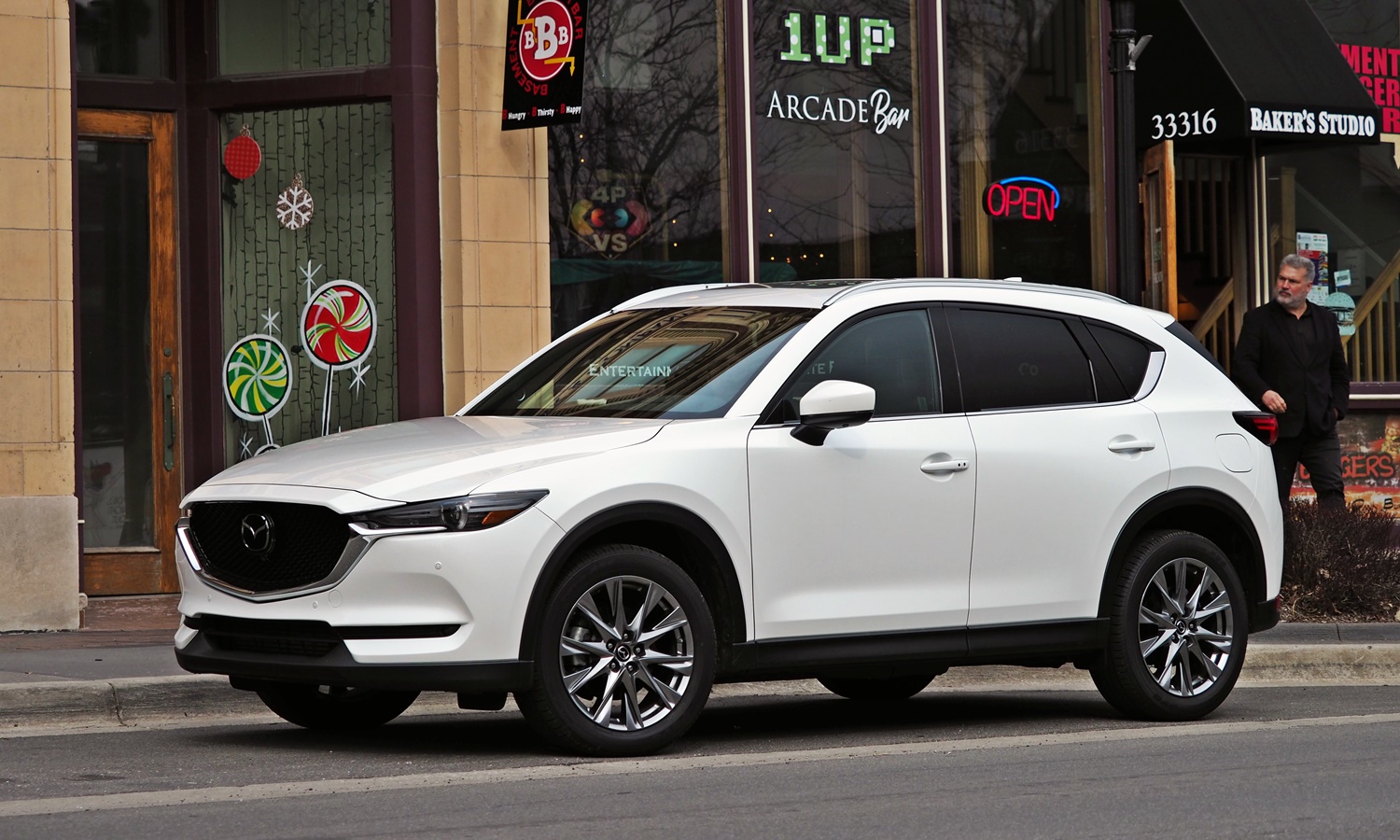
Cleaner, more elegant body sides on the second-gen CX-5. Dramatic curvy character lines deleted. more CX-5 photos
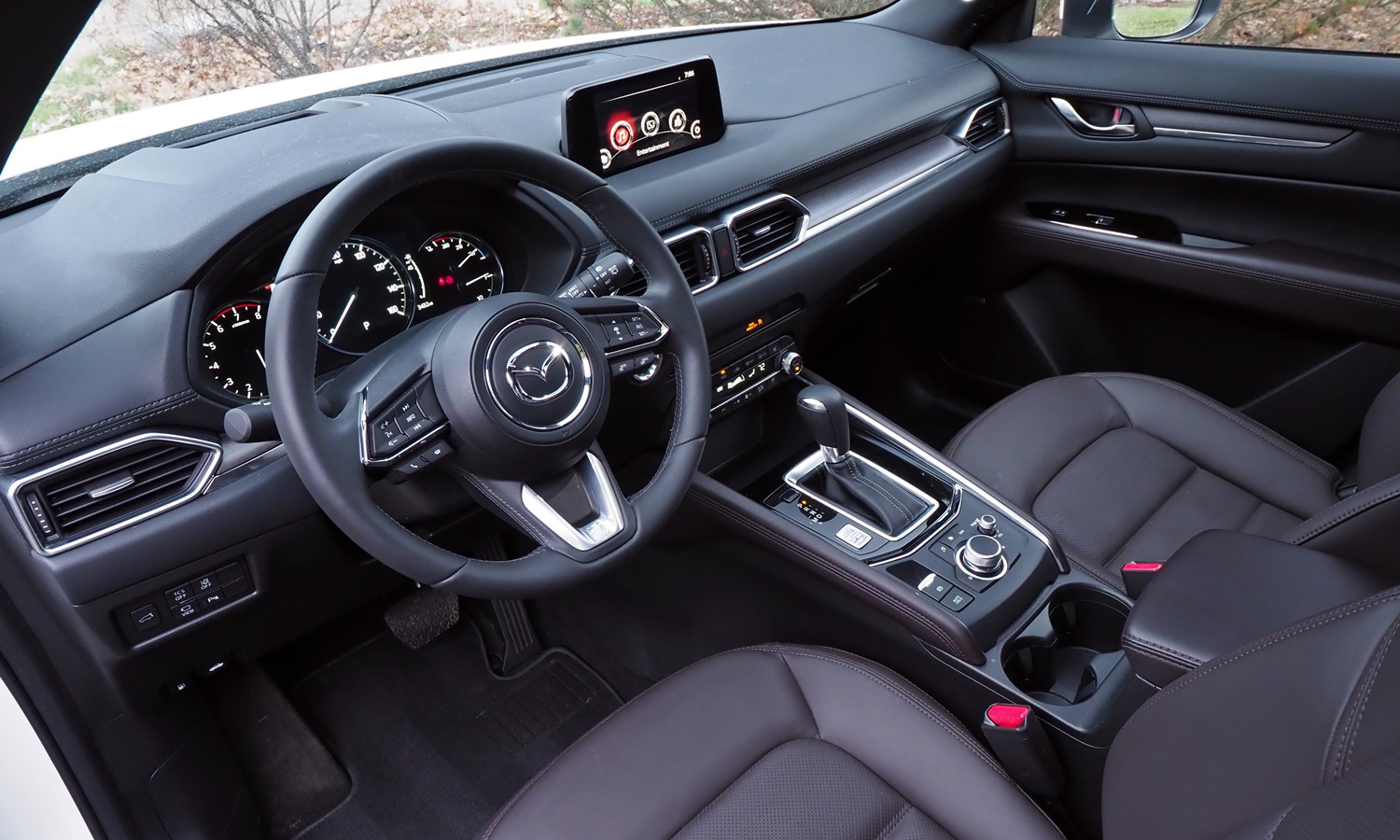
Far more upholstered and stitched surfaces than usual at this price point. Real wood in Signature.
| |
Compared to the RDX |
| Exterior styling |
 Better
Worse
Better
Worse
|
When I reviewed the 2017 Mazda CX-5, I listed styling first among the vehicle's strengths. Adding a turbo to the engine hasn't changed this--it's still a great-looking SUV, especially among those with affordable price tags. It looks sophisticated and expensive without being in-your-face. I only wish the wheel opening trim wasn't black, as this makes the openings around the wheels appear larger than they actually are, the opposite of what most people want. After all, the point of the Signature's 19-inch wheels is to visually fill the openings.
In the earlier review, when I compared the Mazda to the Honda CR-V I found the latter's exterior "overwrought." The CR-V's fancy cousin, the Acura RDX, is even more overstyled, plus a larger grille and more chrome. Take away the bling and cartoonish face and there's nothing special about the crossover's shape. The Mazda appears more tasteful and artful. It has better bones.
| Interior styling |
 Better
Worse
Better
Worse
|
The same differences extend to the vehicle's interiors, only more so. While the Mazda CX-5's interior styling is tastefully restrained--calling it "classic" isn't even a small stretch--the Acura RDX's has a tremendous amount going on, including red-on-silver instruments, a large dial on the center stack for selecting the drive mode, an array of buttons to operate the transmission, a touchpad for operating the infotainment system, and much shiny silver trim. Is the RDX's interior visually exciting or overwhelming? Eye of the beholder. If you enjoy feeling like you're piloting a starship, the Acura's the clear choice. But if your personal style tends towards classic understatement, go with the Mazda.
Both tested vehicles were fitted with red seat upholstery. The interiors differing characters carry over to the selected tone of red, with that in the Mazda appearing almost brown in all but the brightest light and that in the Acura the color of fresh blood.
Both interiors include extensive upholstered-and-stitched surfaces. If either has an edge in interior materials it's small enough that I'd need to examine the two back-to-back to discern it. Both manfacturers have successfully stepped up their games in this area. This is more of a surprise with the Mazda, since it hasn't been considered even a semi-upscale brand.
This said, I wasn't as impressed by the CX-5 Signature's interior as I was by the Mazda6 Signature's, but this says more about the latter--it really blew me away, vastly exceeding my expectations--than the former.
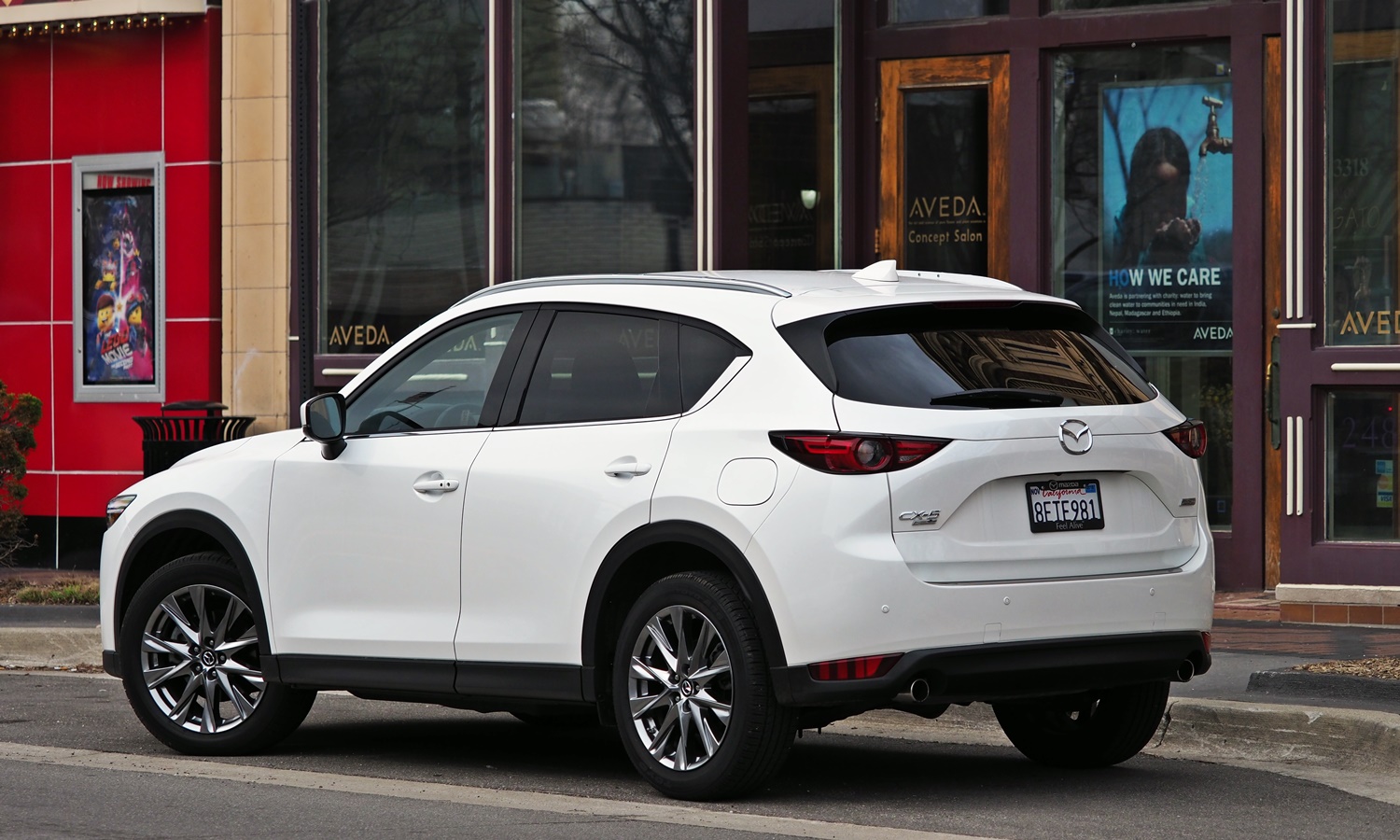
Truncated tail. Elegant and sporty, but not good for cargo-hauling capacity.
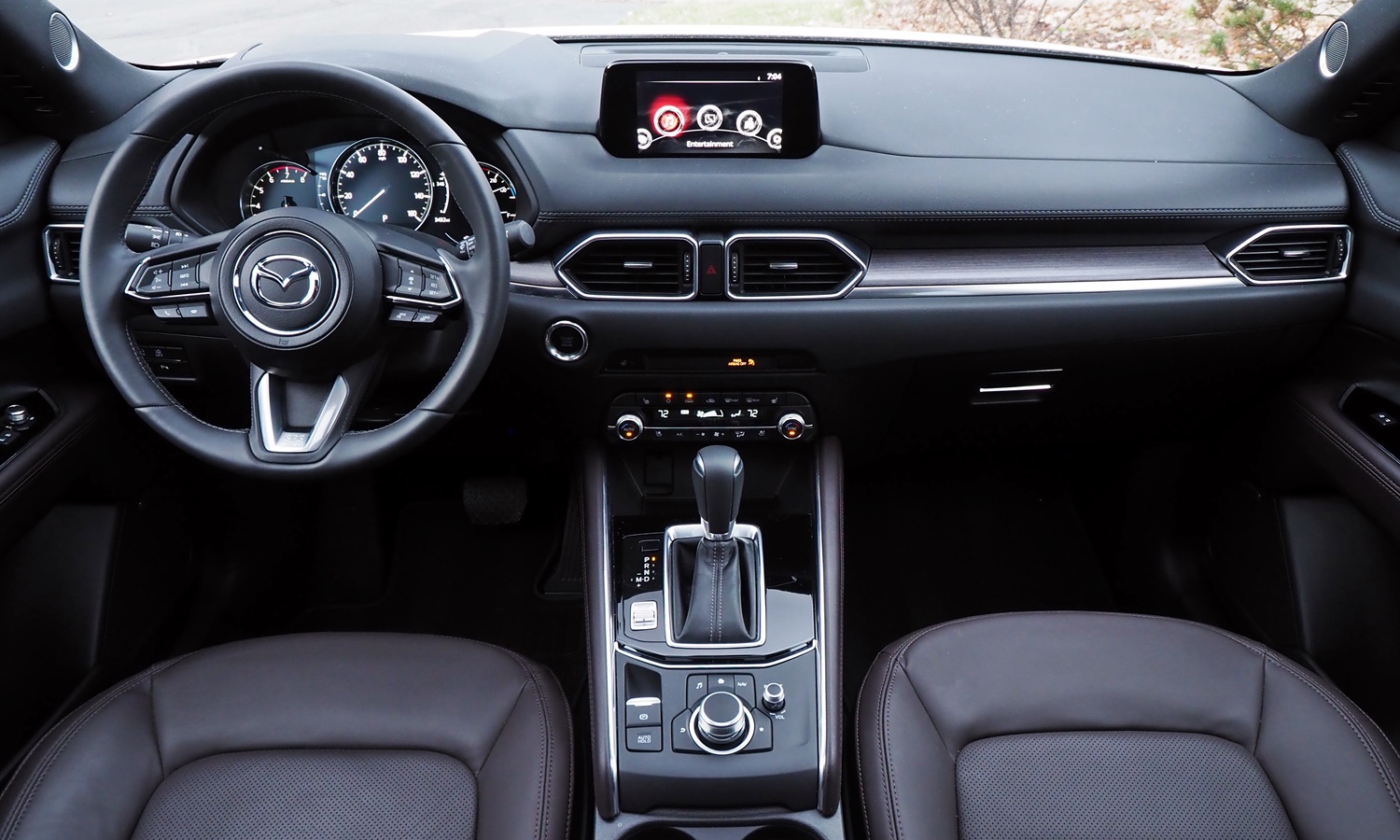
Easy controls, but slow responses and smallish screen.
| Powertrain performance |
 Better
Worse
Better
Worse
|
When I reviewed the 2017 Mazda CX-5, I wished for a more powerful engine option. For 2019, this has been provided, at least in the top two trim levels, via the same 250-horsepower (227-horsepower on regular gas) turbocharged 2.5-liter four-cylinder engine as in the CX-9 and in the top-trim Mazda6. This torquey engine peaks too low to sound or feel thrilling, but delivers well-beyond-adequate acceleration with seemingly little effort. The transmission is behind the curve with only six ratios, but the turbocharged engine's plentiful torque makes tightly spaced ratios (absent here) less necessary. And the transmission does select among those available with alacrity. Unlike in the RDX and in the Mazda6, no shift paddles adorn the steering wheel.
The redesigned 2019 Acura RDX uses the turbocharged 2.0-liter four-cylinder engine introduced in the 2018 Accord, but with more horsepower than in the Accord, 272 vs. 252. Though this engine produces more peak power than the CX-5's, it's less powerful at lower engine speeds, as indicated by their torque figures (280 vs. 310 lb-ft). The RDX also weighs a couple hundred pounds more than the CX-5 (4,019 vs. 3,825). So, even with the benefit of four additional transmission gear ratios, the Acura isn't quite as quick as the Mazda. That said, the Acura feels quicker than the Mazda thanks to a more rev-happy engine and a much more aggressive exhaust soundtrack. And I mean "soundtrack" literally, as much of the growl is synthetic and piped in through the speakers. Selecting a mode other than sport reduces the volume.
For better, more authentic engine sounds, check out the 279-horsepower 3.5-liter V6 in the previous-generation Acura RDX. But in every other way the new RDX is better, even much better.
Both all-wheel-drive systems effectively distribute torque to temper understeer and maximize traction on curve exits. While the Acura SH-AWD system includes a trick mechanical rear differential, Mazda achieves results nearly as good with a conventional rear differential in all but the most enthusiastic driving.
| Handling |
 Better
Worse
Better
Worse
|
I continue to struggle with listing "handling" as a reason to buy a CX-5. On the one hand, the Mazda crossover handles significantly better than its direct competitors. With relatively communicative steering and a well-damped suspension, the CX-5 is very pleasant to drive (if not as pleasant as the surprisingly good Mazda6 sedan). But is it fun to drive? Sort of, when pressed. But for thrilling dynamics in a crossover it remains necessary to spend much extra money for a Porsche, Jaguar, or Alfa. The turbo engine has little impact here.
Note that I didn't say "a little extra money for an Acura." The RDX's steering feels quicker and thus a touch sportier than the CX-5's, but it also feels more insulated and less communicative. Even with brake-based torque vectoring and an active rear differential, the Acura feels heavier and less agile than the Mazda. This is partly because it is longer, wider, and heavier than the Mazda despite having similar interior dimensions (save shoulder room). This said, the new RDX steers and handles far better than the previous one, which had overly light feel-free steering and iffy control over body motions.
A Volvo XC40 feels more agile than either the CX-5 or the RDX, and I had the most fun driving it among the three. But the Volvo is significantly smaller--with five inches less length than the Mazda and a foot less length than the Acura, so it's not entirely fair to compare it.
| Price or payments |
 Better
Worse
Better
Worse
|
Mazda CX-5 pricing starts at $25,345. The top-of-the-line Signature lists for $37,885, and options on the tested vehicle (including $200 for white paint and $400 for illuminated door sill trim plates) brought its bottom line to $39,330.
Nearly $40,000 might seem like a lot for a compact crossover without a prestigious badge. But a similarly equipped Chevrolet Equinox lists for about $2,000 more (before rebates return its price to the vicnity of the Mazda's). And the Chevrolet's interior isn't nearly as nice as the Mazda's.
Acura RDX pricing starts near where the CX-5's ends, at $38,395. But this price doesn't even include AWD, which adds $2,000. To get all of the features on the CX-5 Signature, you must step up to the top-trim on the Acura, which brings its price to $48,495.
The Acura has a more prestigious badge, and does look and feel a little more upscale. But is it worth another $10,000?
| |
Compared to the RDX |
| Driving position & visibility |
 Better
Worse
Better
Worse
|
When my sister was recently shopping for a new compact crossover I recommended the CX-5. She rejected the Mazda because she couldn't see out of it well. Compared to other crossovers you sit relatively low behind a high instrument panel. This helps if you prefer cars to crossovers, but not if you're buying a crossover for superior outward visibility. The Subaru Forester my sister bought has a much higher seating position and much larger windows. The Acura RDX falls between the two in this regard.
The RDX has different driving position issues. Some people might mind the tall, somewhat intrusive center console.
| Front seat support & comfort |
 Better
Worse
Better
Worse
|
Back in 2017 I found the CX-5's driver seat insufficiently bolstered and not especially comfortable. You might think that they'd add sport seats when adding a turbo to the engine, but they did not. The Acura's front seats have much larger side bolsters and provide much better lateral support in curves. Step up to the Advance trim and the bolsters become adjustable.
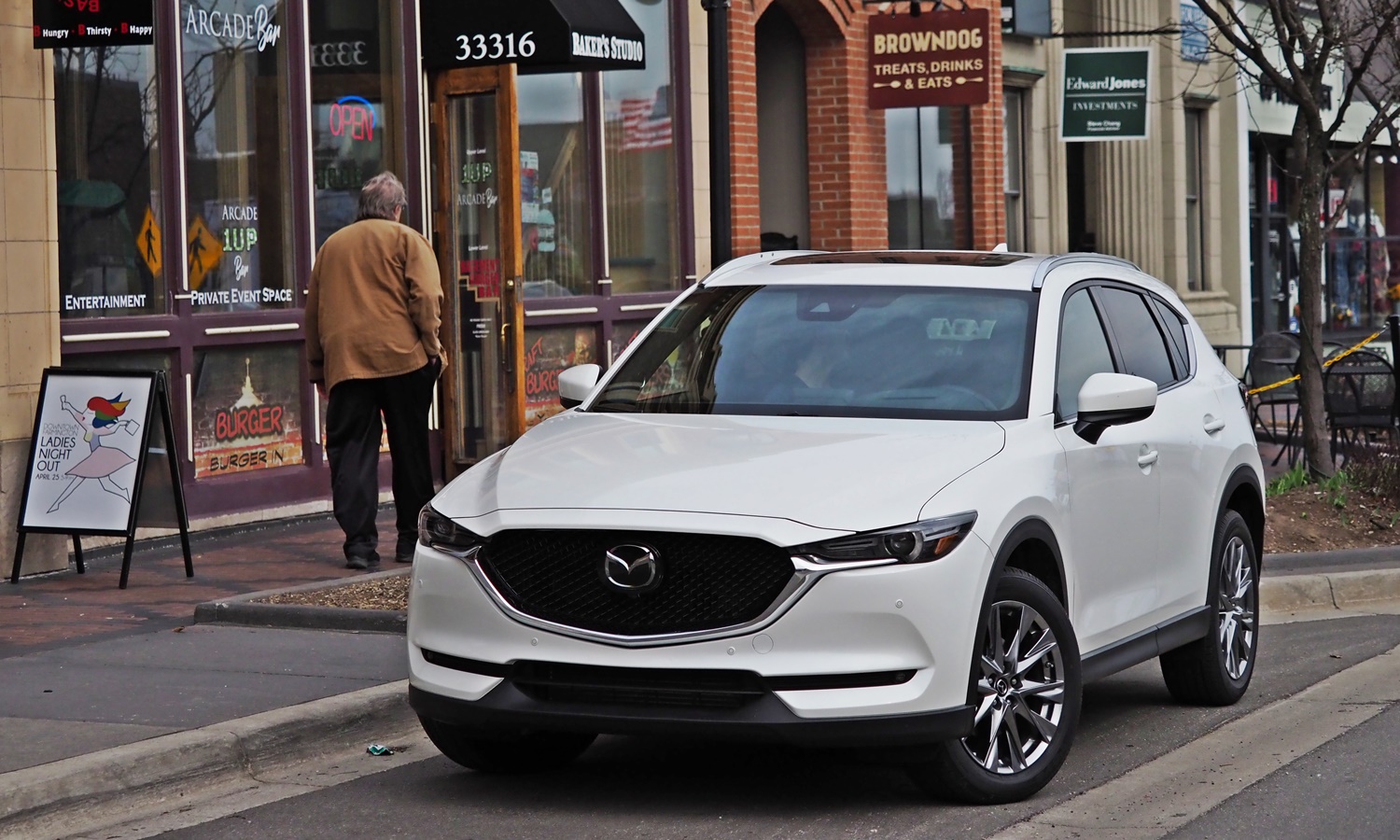
Large grille highlighted by chrome trim, but a clean face by current standards.
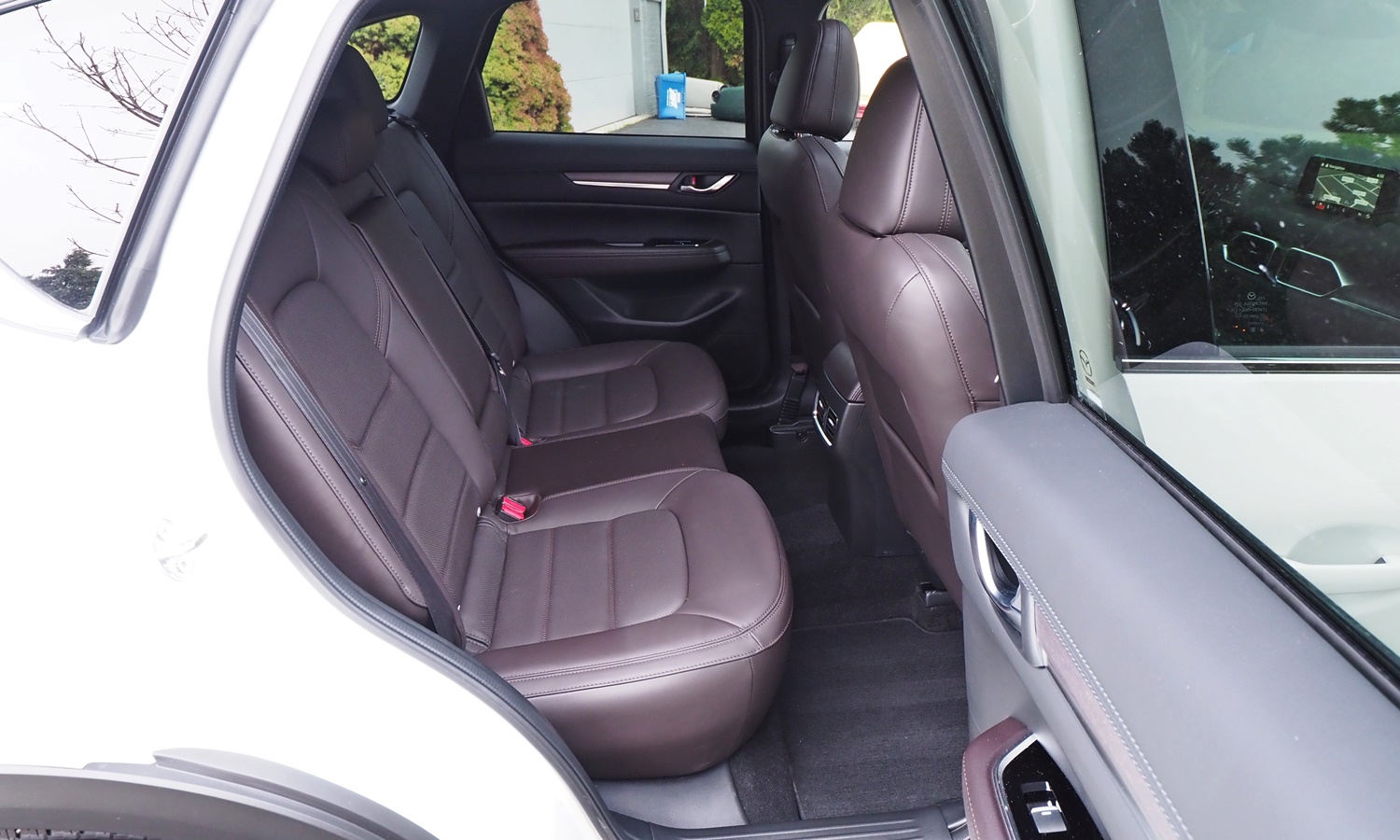
A passable rear seat. Most competitors (but not the RDX) are much roomier.
| Audio & nav systems |
 Better
Worse
Better
Worse
|
Neither car has a stellar infotainment interface and system. While the CX-5's knob-based interface is relatively easy to operate, the infotainment system responds slowly and its screen is small by current standards. The Acura has quicker responses and a larger screen, but its touchpad-based interface requires more time to learn and get used to than I had during a brief drive. Hopefully it's not as awful as the touchpad-based systems in Lexus models.
| Rear seat room & comfort |
 Better
Worse
Better
Worse
|
According to the official specs, the Mazda CX-5 offers about a half-inch more rear legroom than the RDX. In reality, though, the Acura has an extra inch or so. While neither is cramped, you'll find significantly more rear seat legroom in a Honda CR-V, Subaru Forester, or Toyota RAV4.
If you'll be putting three people in back, the Acura does have the advantage of two additional inches of shoulder room. The RDX's additional width might not be good for handling agility, but it is very good for a rear center passenger.
| Cargo capacity |
 Better
Worse
Better
Worse
|
If you want the compact crossover capable of carrying the most cargo, the Mazda CX-5 isn't it. You can stuff far more of your stuff into the Honda CR-V, Nissan Rogue, Subaru Forester, Toyota RAV4, or Volkswagen Tiguan. Blame the Mazda's relatively long hood, relatively short tail, and sporty stying.
While cargo volume specs should only be compared with much caution--different methods can yield vastly different results--the official numbers for the CX-5 and CR-V seem to accurately reflect the real-world difference between them. With the rear seats up, the Mazda can carry 30.9 cubic feet, the Honda 39.2. With the rear seats folded they can hold 59.6 and 75.8 cubes, respectively.
The Acura RDX has cargo volume specs similar to the Mazda's and similarly less impressive than those of its corporate cousin. In general upscale crossovers are tighter inside than those from mainstream brands due to sportier styling, upgraded body structures, and plusher seats.
| |
Compared to the RDX |
| Fuel economy |
 Better
Worse
Better
Worse
|
Neither the Mazda CX-5 (with the turbocharged engine) or the Acura RDX gets stellar fuel economy. In the EPA's tests the CX-5 manages 22 mpg city and 27 mpg highway. This compares with 24 and 30, respectively, with the non-turbocharged engine, so the penalty for the additional performance isn't large, about ten percent.
The RDX with AWD rates 21/27, unless you get the performance-oriented A-Spec. Then it scores 26 mpg on the highway. Unlike the turbocharged Mazda, you can get the RDX with front-wheel-drive, in which case the EPA scores improve by a single mpg.
Other similarly powerful compact crossovers earn similar mpg ratings. The Chevrolet Equinox with a 2.0T engine and AWD scores 22/28. An Audi Q5 with the same scores 22/27.
There is an outlier: the Infiniti QX50, with an innovative variable compression engine and a CVT, rates 24/30. But the Infiniti doesn't drive nearly as well as the others.
Mazda recently introduced a diesel engine for the CX-5. Compared to the non-turbo gas engine it gets another three mpg in city driving but shockingly does no better on the highway. A Chevrolet Equinox diesel with AWD earns a far higher 38 mpg rating. This might explain why it took so long for Mazda to bring its diesel engine to the American market--it offers too little benefit for its higher cost.
| Quietness |
 Better
Worse
Better
Worse
|
While the Mazda CX-5's steering and handling improved only marginally with its 2017 redesign, its ride quality, noise levels, and overall refinement improved dramatically. Though some mildly imperfect road surfaces induce small but fairly sharp vertical reactions from the CX-5's suspension (a common sportyish crossover issue), the Mazda otherwise rides smoothly. Aside from some buzziness from the engine when worked--less of an issue with the turbocharged engine, as it has to work hard less often--noise levels are low.
In general the second-generation CX-5 feels more solid and more polished than the original. This is perhaps most obvious when closing the doors, a test in which past Mazdas, engineered for minimum mass, rarely performed well. Among direct competitors, the Equinox might have a smoother, quieter ride, but the CX-5 has an edge over the others.
The Acura RDX is about equally quiet--if we ignore the plentiful semi-synthetic engine growl. The Mazda might have an advantage in ride quality. I say "might" because I drove the RDX in sporty A-Spec trim, which has larger wheels and lower profile tires (size 255/45VR20) than other RDX trims (235/55HR19) and than the Mazda (225/55VR19). The Advanced trim includes adaptive dampers, which could return the advantage to the Acura. Even if this is the case, that I've even been comparing the CX-5 to Acura's updated and upgraded "we're really a premium vehicle this time, not just a fancy Honda" crossover says a lot about the Mazda.
With sophisticated styling, a well-appointed interior, a torquey engine, polished handling, and a refined ride, the Mazda CX-5 Signature largely delivers the look and feel of a premium compact crossover at a mainstream price. Some bits aren't quite there, most notably the seats and infotainment system. And the Mazda6 Signature looked and felt even more upscale. But overall the CX-5 suggests that Mazda is serious about moving upmarket, and can do so credibly (assuming they can similarly upgrade their sales and service).
The Acura RDX makes a bolder statement, and thus justifies its higher price for those who want to make such a statement. It has more glitz inside and out, quicker steering, a rortier engine, and a more prestigious badge. It delivers a more overtly sporty driving experience than the Mazda, especially in A-Spec trim. But neither is all that exciting to drive.
Mazda, to its credit, isn't pretending that its turbocharged engine transforms the CX-5 into a high-performance vehicle. Instead, with the Signature trim it emphasizes luxury. Look, Ma, no shift paddles!
Subjectively, I continue to have trouble perceiving the Mazda as the Acura's equal. The RDX somehow seems like more car. But go through the two area by area as objectively as possible, and the Mazda seems quite competitive, and thus a much better value. Plus, if you prefer your "classy" without the quotes, it will prove the more satisfying crossover.
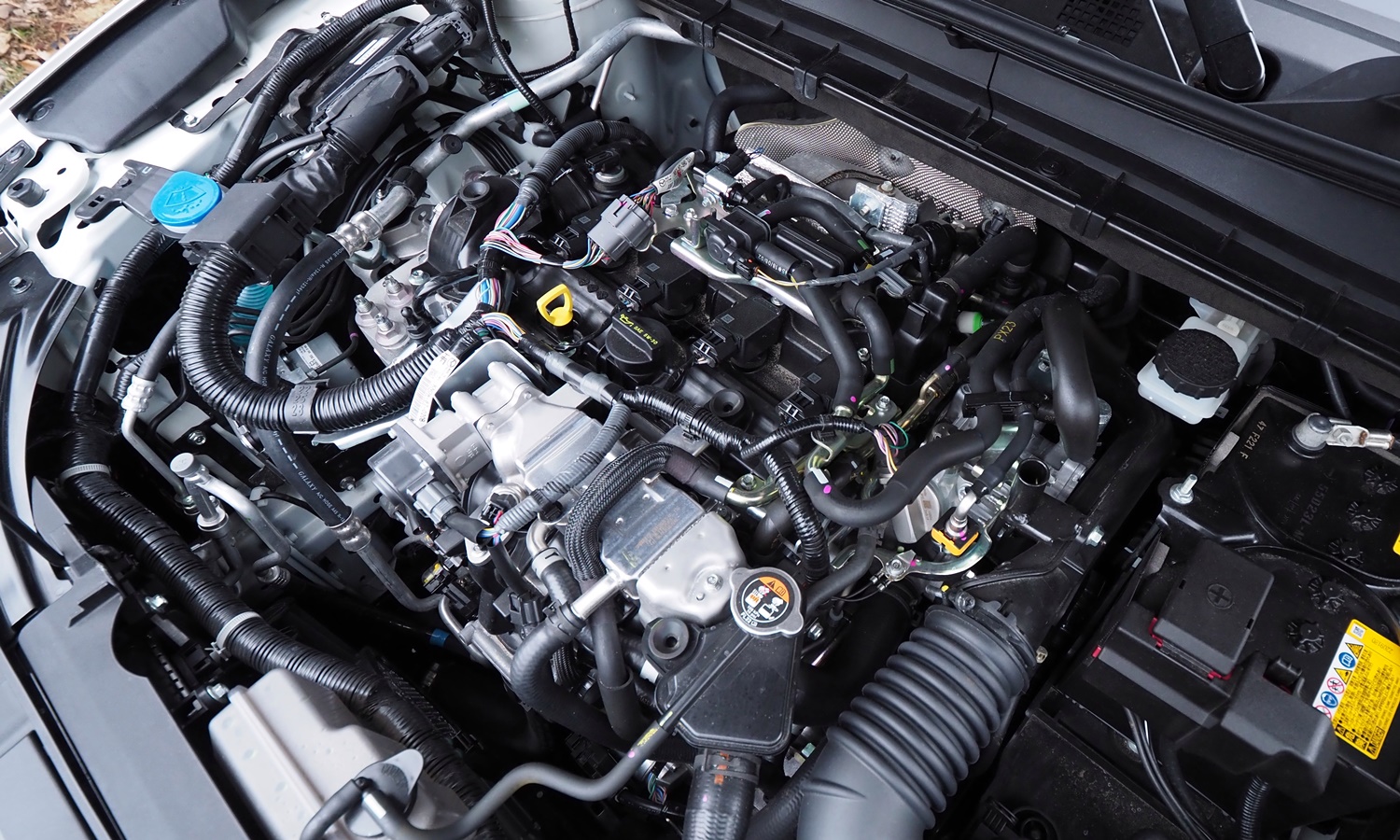
Turbocharger tucked behind engine. Not thrilling, but torquey.
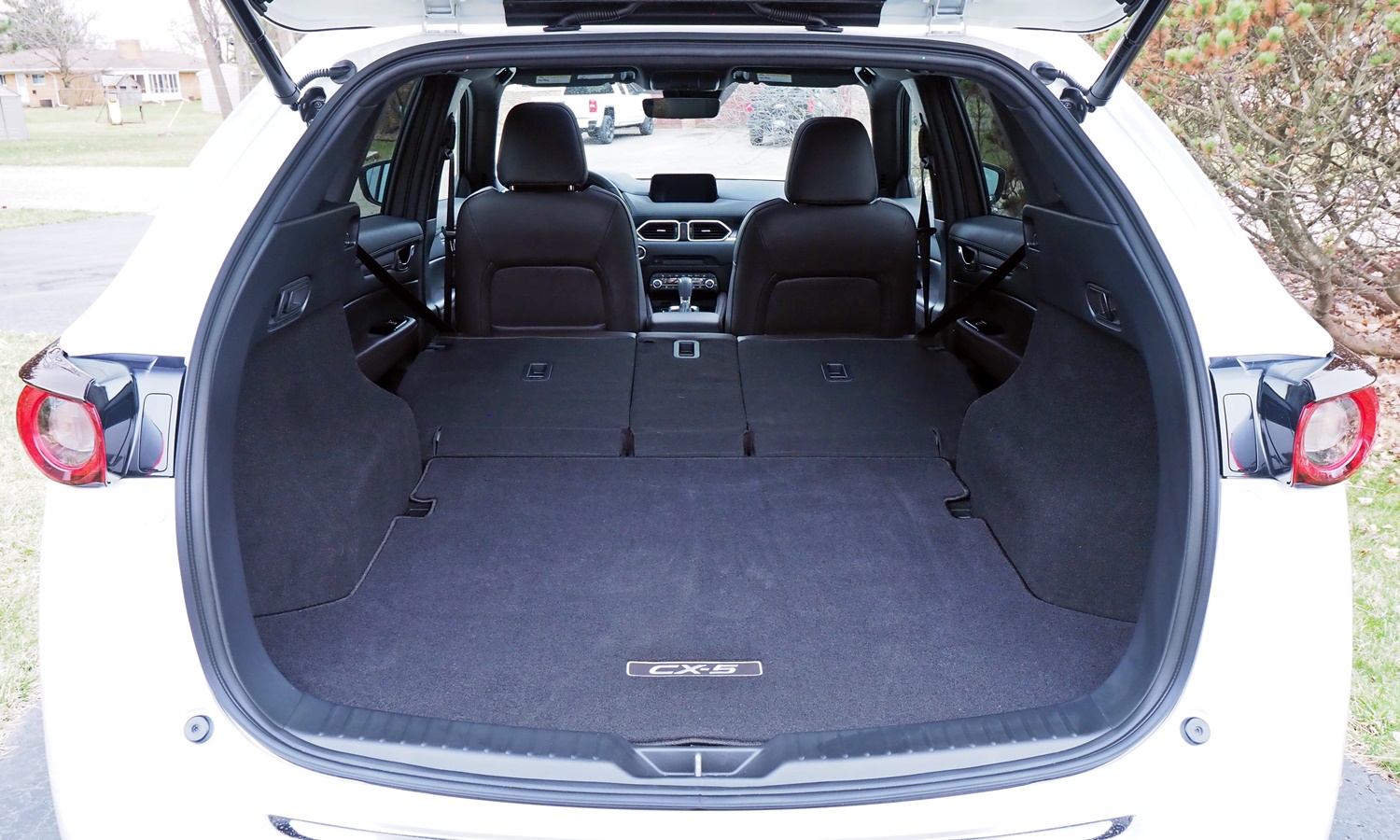
Less cargo space than in many competitors. But possibly all you need.
See more 2019 Mazda CX-5 photos
Mazda provided an insured car for a week with a tank of gas. Acura provided a car at a regional media association event.











